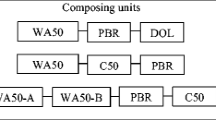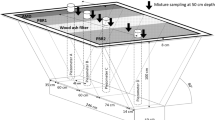Abstract
The efficiency of serpentinite as an alternative alkalinity generating material for the passive treatment of acid mine drainage (AMD) was assessed in the laboratory. Three series of batch experiments were designed for the passive treatment of a low pH (1.6) AMD synthetic solution containing 2,500 ppm Fe2+, 6,600 ppm SO 2−4 , 10.5 ppm Al, 15 ppm Ni, and traces of Cr, Mn and Cu. The influencing factors studied were: the effect of water/rock ratio, residence time, type of the alkalinity generating material (dolomite, magnesite, marble, serpentinite), and nature of the system (open vs. closed cells). The variations in solution chemistry observed in the open cells indicate that a lower water/rock ratio (0.33 ml/g) was the most efficient for metals removal. The optimal residence time in open cells was 24 h to reach the higher pH values. In the closed cells laboratory setup, synthetic AMD was placed in contact with the various alkaline materials for three different contact times (24, 48, 72 h). The optimal pH was reached after 48 h and did not change appreciably for longer contact time, and the best results for metal removals were obtained with marble and serpentinite. Single treatment efficiency was compared with a successive treatment approach. The most promising results were obtained with a five step treatment: (1) pre-treatment in a closed cell using serpentinite, (2) aeration and settling, (3) treatment in an open cell using marble, (4) final aeration and settling, and (5) filtration with a coarse silica sand. With this configuration, the final pH was 6.5 and pronounced metals depletion was achieved (100% for Al, 99.95% for Fe, 85.7% for Ni).














Similar content being viewed by others
References
Annuaire des Minéraux du Canada (1994) Les sulfates, Natural Resources Canada
Aubertin M, Bussiere B, Bernier L (2002) Environnement et gestion des rejets miniers CD-ROM. Presses Internationales Polytechnique, Montréal
Bernier L, Aubertin M, Dagenais AM, Bussiere B, Bienvenu L, Cyr J (2001) Limestone drain design criteria in AMD passive treatment: theory, practice and hydrogeochemistry monitoring at Lorraine Mine Site, Temiscamingue. In: CIM Minespace 2001 annual meeting proceedings technical paper 48. CIM, Quebec, p 9
Bernier L, Aubertin M, Poirier C, Bussiere B (2002) On the use of limestone drains in the passive treatment of acid mine drainage (AMD). In: Symposium on environment and mining: challenges and perspectives, Rouyn-Noranda. ICM/CIM, p 19
Bethke CM (1996) Geochemical reaction modeling. Oxford University Press, New York, p 397
Bethke CM (2002) The geochemist’s workbench Release 4.0 A users guide to Rxn, Act2, Tact, React, and Gtplot, Hydrology Program, University of Illinois, p 224
Cheng X, Sinclair AJ (1995) Metasomatic norms and mass balance chemico-mineralogic models of hydrothermal alteration systems. Exploration Mining Geology 4:365–379
Cravotta CA III, Trahan MK (1999) Limestone drains to increase pH and remove dissolved metals from acidic mine drainage. Appl Geochem 14:581–606
Cravotta CA III, Watzlaf GR (2002) Design and performance of limestone drains to increase pH and remove metals from acidic mine drainage. In: Naftz DL, Morrison SJ, Fuller CC, Davis JA (eds) Handbook of groundwater remediation using permeable reactive barriers: applications to radionuclides, trace metals and nutrients. Academic, New York, pp 19–65
Faulkner BB, Skousen JF (1994) Treatment of acid mine drainage by passive systems. US Bur. Mines SP-06A-94,.250–257
Fingle E (1980) Laxatives and cathartics. In: Pharmacological basis of therapeutics. McMillan Publishing Co, New York
Gusek JJ (1995) Passive-treatment of rock drainage; what is the potential bottom line? Mining Engineering. 47:250–253
Gusek JJ (2001) Why do some passive treatment systems fail? http://www.dartmouth.edu/~cehs/CAGsite/cleanup/treatment.htm
Guyer PQ (1996) Livestock water quality, University of Nebraska NebGuide,electronic version of File G467 under: Beef A-29 Feeding & Nutrition. http://www.ianr.unl.edu/pubs/beef/g467.htm
Hedin RS, Watzlaf GR (1994) The effects of anoxic limestone drains on mine water chemistry. In: Proceedings of the international land reclamation and mine drainage conference, Pittsburgh, pp 185–194
Herrmann W, Berry RF (2002) MINSQ—a least squares spreadsheet method for calculating mineral proportions from whole rock major element analyses, geochemistry: exploration, environment, analysis. 2:361–368
Hillel D (1998) Environmental soil physics. Academic, San Diego, p 771
Kleinman RLP (1989) Acid mine drainage: U.S. Bureau of Mines researches and develops control methods for both coal and metal mines. Eng Mining J 190:16I–16K
Kleiv RA, Thornhill M, Sandvik KL (2001) Pre-treatment of acid mine drainage using magnesium olivine. In: Proceedings of Securing the future symposium, Skellefteå, pp 346–342
McConchie D, Clark M, Maddocks G, Davies_McConchie F, Pope S, Caldicott W (2003) The use of BAUXOLTM technology in mine site management and remediation. In: Procceedings CIM mining industry conference and exhibition CD-ROM, Montreal 2003, paper MOAM-730
Mine Environment Neutral Drainage (MEND) (1999) Review of passive systems for treatment of acid mine drainage. Report 3.14.1, Ottawa
Paterson DW, Wahlstrom RC, Libal GW, Olson OE (1979) Effects of sulfate in water on swine reproduction and young pig preformance. J Animal Sci 49(3):664
Simmons JS, Ziemkiewicz P (2003) An alternative alkaline addition for direct treatment of acid mine water. In: Proceeding of the Sudbury 2003 mining and the environment conference CD-ROM http://www.sudbury2007.ca
Skousen J, Ziemkiewicz P (1999) The latest technologies to control and treat acid mine drainage. In: Appalachian rivers II conference, 28–29 July 1999
USEPA (1985) US Environmental Protection Agency. National primary drinking water regulations: synthetic organic chemicals, ionorganic chemicals and microorganisms; proposed rule. Fed Regist 50(219):46936
Ziemkiewicz PF, Skousen JG, Brant DL, Sterner PL, Lovett RJ (1997) Acid mine drainage treatment with armoured limestone in open limestone channels. J Environ Quality 26:1017–1024
Ziemkiewicz PF, Skousen JG, Simmons J (2003) Long-term performance of passive acid mine drainage treatment systems. Mine Water Environ 22:118–129
Acknowledgements
This research was supported by the NSERC Polytechnique-UQAT Industrial Chair on Environment and Mine Wastes http://www.enviro-geremi.polymtl.ca/. I would like to thank C. Dallaire and E. Bélanger of École Polytechnique and J. Groleau and L. Mongeon from Noranda Technology Centre for their technical assistance. Luc St-Arnaud and Robert Prairie from Noranda Inc.—Falconbridge provided helpful comments. A thorough review of this paper was done by professor emeritus Wallace H. MacLean from McGill University. Comments from an anonymous reviewer were helpful and greatly appreciated.
Author information
Authors and Affiliations
Corresponding author
Rights and permissions
About this article
Cite this article
Bernier, L.R. The potential use of serpentinite in the passive treatment of acid mine drainage: batch experiments. Environ Geol 47, 670–684 (2005). https://doi.org/10.1007/s00254-004-1195-9
Received:
Accepted:
Published:
Issue Date:
DOI: https://doi.org/10.1007/s00254-004-1195-9




